Based on Your Reading:
Get Your Free Mesothelioma Guide

Find a Top Mesothelioma Doctor

Access Help Paying for Treatment

Mesothelioma is a rare malignant cancer that develops in the lining of the lungs, abdomen, chest wall or testes. About 3,000 new mesothelioma cases or approximately 1 per 100,000 people are diagnosed with this rare cancer in the U.S. each year. Asbestos exposure is the primary cause of mesothelioma.
Written by Michelle Whitmer • Edited By Walter Pacheco • Medically Reviewed By Dr. Jacques Fontaine
The Mesothelioma Center at Asbestos.com has provided patients and their loved ones the most updated and reliable information on mesothelioma and asbestos exposure since 2006.
Our team of Patient Advocates includes a medical doctor, a registered nurse, health services administrators, veterans, VA-accredited Claims Agents, an oncology patient navigator and hospice care expert. Their combined expertise means we help any mesothelioma patient or loved one through every step of their cancer journey.
More than 30 contributors, including mesothelioma doctors, survivors, health care professionals and other experts, have peer-reviewed our website and written unique research-driven articles to ensure you get the highest-quality medical and health information.
My family has only the highest compliment for the assistance and support that we received from The Mesothelioma Center. This is a staff of compassionate and knowledgeable individuals who respect what your family is experiencing and who go the extra mile to make an unfortunate diagnosis less stressful. Information and assistance were provided by The Mesothelioma Center at no cost to our family.LashawnMesothelioma patient’s daughter


Whitmer, M. (2024, April 1). Mesothelioma Statistics. Asbestos.com. Retrieved April 11, 2024, from https://www.asbestos.com/mesothelioma/statistics/
Whitmer, Michelle. "Mesothelioma Statistics." Asbestos.com, 1 Apr 2024, https://www.asbestos.com/mesothelioma/statistics/.
Whitmer, Michelle. "Mesothelioma Statistics." Asbestos.com. Last modified April 1, 2024. https://www.asbestos.com/mesothelioma/statistics/.
Men older than age 65 with occupational backgrounds in the military, construction, industry, mechanics and firefighting are at particularly high risk for developing mesothelioma. Use of asbestos products was widespread in these fields. However, anyone with a history of asbestos exposure is at risk.
Asbestos workers with years of exposure have an 8% to 13% risk of mesothelioma. The chances of developing mesothelioma from asbestos exposure increase with continued exposure. Doctors call this a dose-response relationship. However, research shows no amount of asbestos exposure is safe, according to the World Health Organization.
Secondary asbestos exposure is also a risk for family members of asbestos workers. This exposure has led to mesothelioma in spouses and children of asbestos workers.
Mesothelioma is a rare type of cancer that develops in the lining of the lungs (pleura) and chest wall. It also occurs in the lining of the abdomen (peritoneum) or the tissue surrounding the testes (tunica vaginalis) or heart.
Mesothelioma incidence describes the risk of developing mesothelioma cancer. Our information comes from medical journals, cancer research organizations and the National Cancer Institute’s Surveillance, Epidemiology and End Results Program. The most recent year of cancer incidence data available from the U.S. Centers for Disease Control and Prevention and SEER is from 2020.
In 2020, mesothelioma was 2.4 times more likely to occur in men than women. Research and historical data show that men were more likely than women to hold jobs that used asbestos.
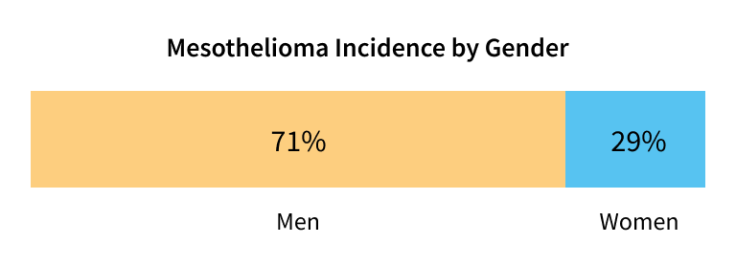
Of the 2,681 mesothelioma cases diagnosed in 2020, men accounted for 1,900 cases and women accounted for 781 cases. That means approximately 71% of mesothelioma cases occurred in men and 29% occurred in women.
Of all diagnosed patients in 2020, approximately 91% were white. The CDC’s 2020 ethnicity data shows Hispanic people with mesothelioma accounted for approximately 8% of cases.
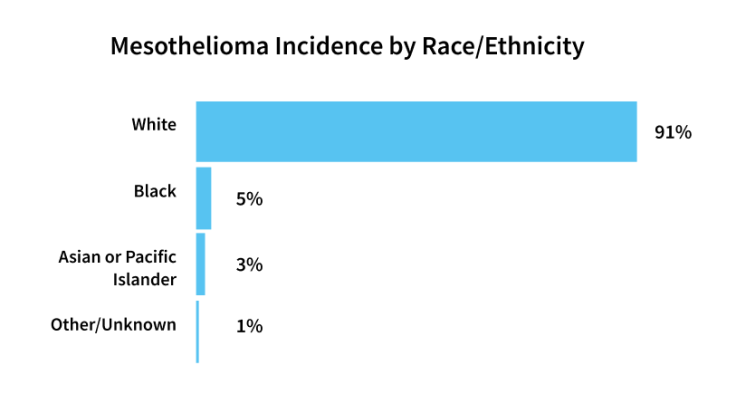
Periodically, the U.S. Department of Labor releases summary statistics about the U.S. workforce. The reports show that Black workers are highly represented in health and education services, public administration and transportation sectors.
They were less likely to be in occupations that used asbestos, such as building and ship construction, insulation work and mining. Historically fewer Black individuals have served in the U.S. Navy, which has been a significant source of asbestos exposure for men.
In 2020, the CDC reported that most people with mesothelioma are diagnosed when they’re between ages 75 and 79. The risk of developing mesothelioma is 10 times higher for those older than 60 compared to those younger than 40.
The average age at diagnosis is the result of the 20- to 60-year latency period between first exposure to asbestos and the development of mesothelioma. This long latency period means older people are more likely to develop the disease.
The latency period is generally shorter for peritoneal mesothelioma than pleural mesothelioma. Most people diagnosed with peritoneal and pleural mesothelioma are about 51 and 67 years old, respectively.
Mesothelioma starts to develop 20 to 60 years after exposure to asbestos. The latency period is the gap between first exposure and the appearance of symptoms.
The latency period of a disease is the amount of time it takes before a patient begins to show or develop symptoms. Asbestos-related diseases have a long latency period.
Because of the long latency period, it isn’t common for people to receive a mesothelioma diagnosis before turning 50 years old. According to an exclusive survey The Mesothelioma Center at Asbestos.com conducted in 2023, only 9% of approximately 220 mesothelioma patients were diagnosed before age 50.
Women tend to have a longer mesothelioma latency period than men. Researchers at M.D. Anderson Cancer Center and Texas Occupational Medicine Institute published a study showing women tend to experience lower levels of asbestos exposure. This may explain the differences in the latency period.
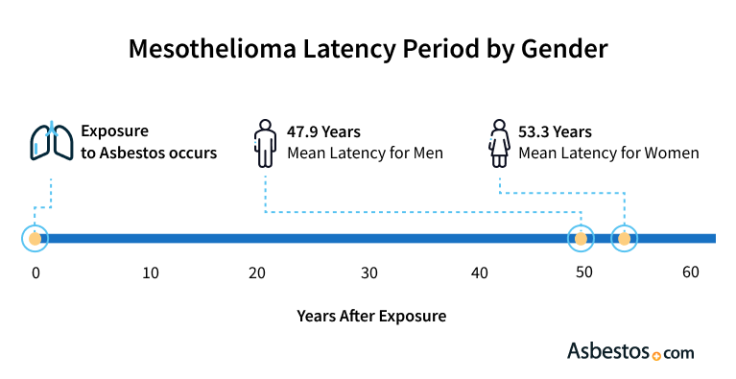
Historically, men had a higher likelihood of exposure to asbestos in their occupations. During periods of extensive asbestos use, men were more commonly working jobs in construction, power generation and factories where they were exposed to high concentrations of asbestos for extended periods of time.
Women have historically been more likely to experience secondhand asbestos exposure, which generally occurs at lower levels and for shorter durations. These lower levels of exposure are linked to a longer latency period, although the specific type of mesothelioma may also influence this period.
The average latency period varies depending on the location of mesothelioma tumors in the body. Researchers don’t yet understand why the latency period is shorter for different types of mesothelioma.
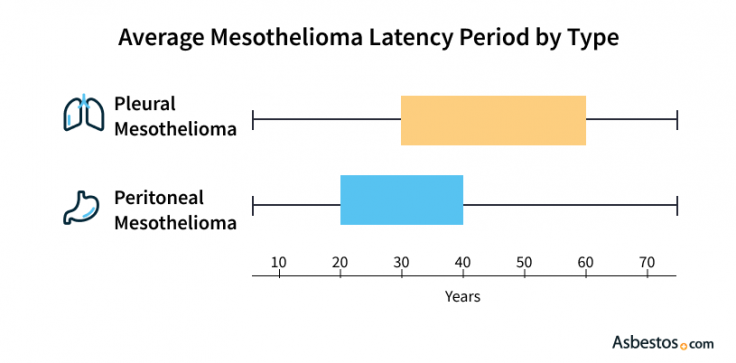
For pleural mesothelioma the average latency period is 30 to 60 years. For peritoneal mesothelioma, it’s 20 to 40 years.
Get Your Free Mesothelioma Guide

Find a Top Mesothelioma Doctor

Access Help Paying for Treatment

Most mesothelioma cases occur in the pleura, the tissue surrounding the lungs. Pleural mesothelioma is the most common type because asbestos usually enters the body through the lungs.
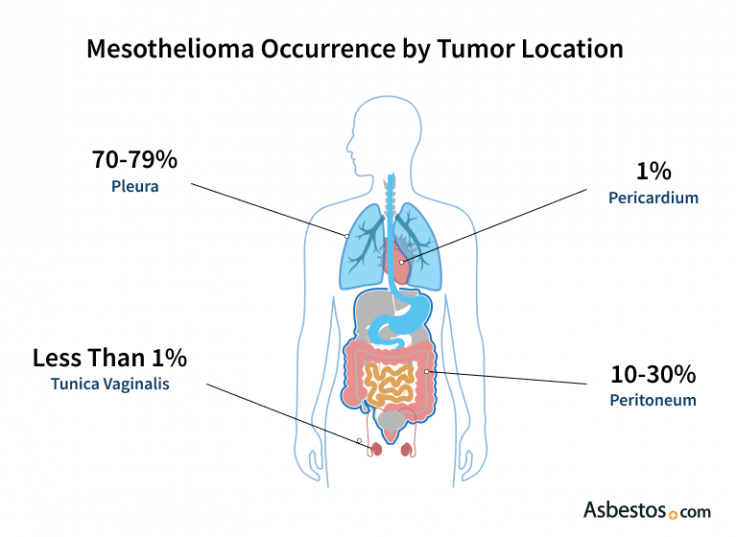
About 20% of mesothelioma cases appear in the lining of the abdomen called the peritoneum. In 1% of cases, this cancer forms in the lining of the heart, called the pericardium. Fewer than 1% of cases occur in the tunica vaginalis, the covering of the testes.
An exclusive survey The Mesothelioma Center at Asbestos.com conducted in 2023 collected diagnosis data on 220 mesothelioma patients. Approximately 73% had pleural, 23% had peritoneal, 1% had testicular and 3% were unsure.
Mesothelioma symptoms vary depending on where this cancer forms. The most common symptoms all mesothelioma types share include fatigue, pain, fever, loss of appetite, effusions and swelling.
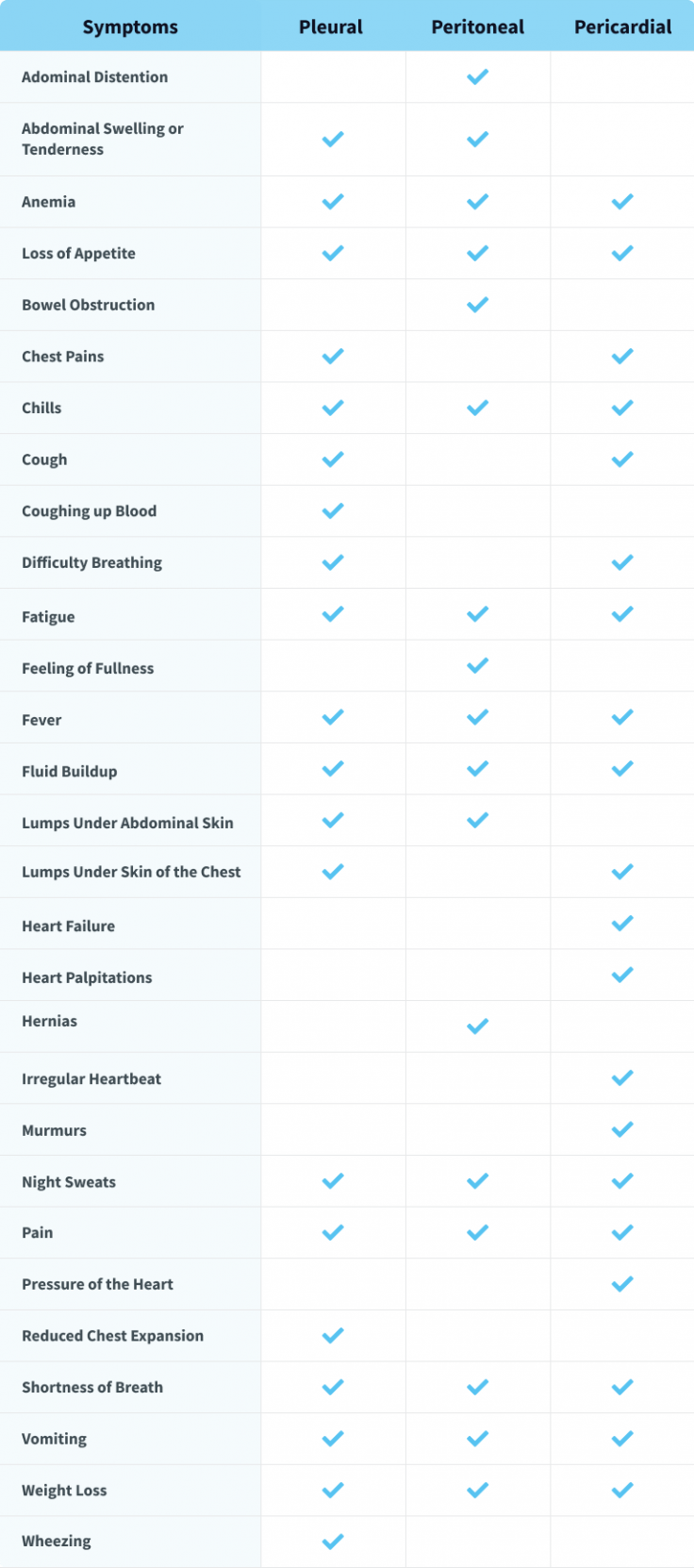
Early-stage symptoms are usually mild or nonexistent. This factor makes mesothelioma challenging to catch early.
Because early detection plays a significant role in available treatment options and survival rates, it’s important to see your doctor as soon as symptoms do develop. For those with a known history of asbestos exposure, mesothelioma screenings are also important for detecting the disease as soon as possible.
Mesothelioma survival rates vary depending on the age and gender of the patient, location of mesothelioma tumors and stage of progression of tumor development. Treatment options also have a significant impact on individual survival. For example, 50% of peritoneal patients who undergo aggressive treatment live longer than 5 years.
While the prognosis for mesothelioma is generally poor compared to other cancers, some patients do experience remission. The Mesothelioma Center’s unique 2023 survey found that doctors told 13% of respondents they were in remission or cancer-free.
Survival rates vary significantly among the different types of mesothelioma. Medical advances have made peritoneal mesothelioma easier to treat than pleural mesothelioma.
A study from Translational Oncology reveals a large difference in survival rates. Most patients survive a year after diagnosis, but peritoneal patients see longer survival rates.
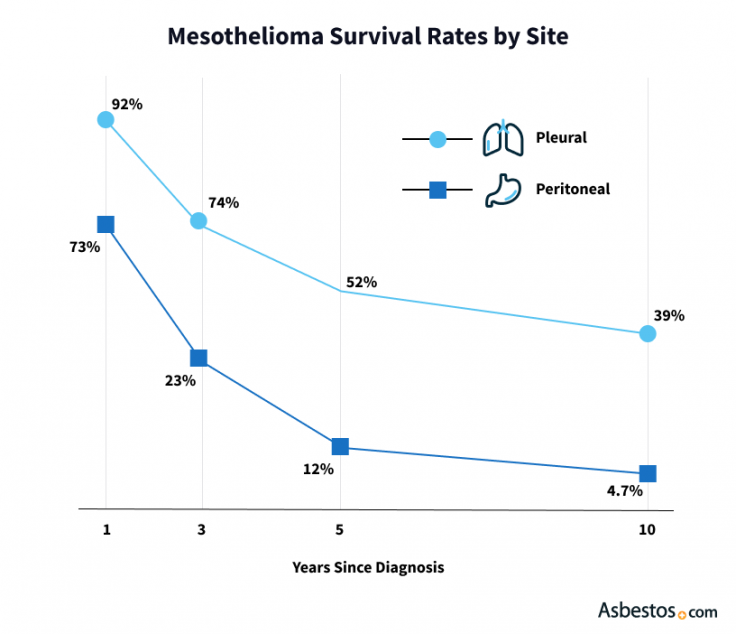
More survival rate data is available for pleural mesothelioma because it’s the most common type. For example, researchers have analyzed pleural survival by stage of tumor progression.
The mesothelioma stage at diagnosis affects the patient’s prognosis, with earlier stages having longer average survival times. Doctors sort pleural mesothelioma cases into stages to describe how far the cancer has spread in the body.
| Mesothelioma Stage | Median Survival Time |
|---|---|
| Stage 1 | 22.2 months |
| Stage 2 | 20 months |
| Stage 3 | 17.9 months |
| Stage 4 | 14.9 months |
Patients have more treatment options and a better prognosis in the early stages. As tumors progress, treatment options diminish and prognosis worsens.
The SEER Program tracks 5-year survival rates. Pleural mesothelioma has three groups: localized, regional and distant stages.
| SEER Stage | 5-Year Survival Rate |
|---|---|
| All SEER Stages | 12% |
| Localized | 24% |
| Regional | 16% |
| Distant | 7% |
When compared to patients with distant tumors, those with localized tumors are more than twice as likely to live at least five years. These statistics underscore the importance of early detection.
Researchers at Wake Forest University School of Medicine evaluated 380 mesothelioma patients and reported a 5-year survival rate of 65.3% for peritoneal mesothelioma. Long-term survival may be better in peritoneal cases because treatments are more effective.
| Year(s) | Peritoneal |
|---|---|
| 1 year | 91.6% |
| 3 years | 73.8% |
| 5 years | 65.3% |
| 10 years | 39.4% |
The SEER program doesn’t track or publish survival rate data for peritoneal mesothelioma, unlike the pleural type. This is likely because pleural cases far outnumber peritoneal cases, so data for the latter is less available or precise.
Survival among women diagnosed with pleural mesothelioma is higher compared to men. The 5-year survival rate for men with pleural mesothelioma is 7.3% compared to 16.4% for women.
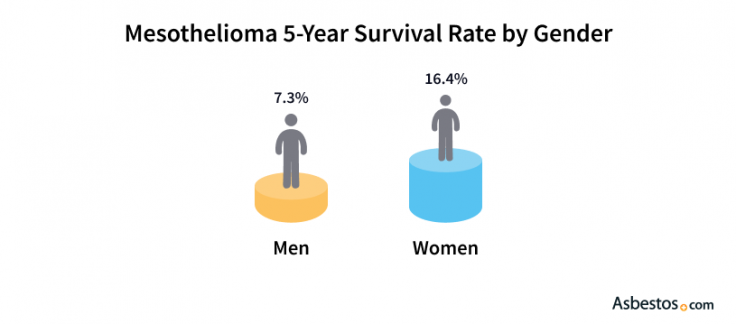
Overall, younger mesothelioma patients have a significantly higher survival rate than older patients. More than 50% of patients diagnosed before the age of 50 survive one year, while less than 33% of those 75 or older survive the same length of time.
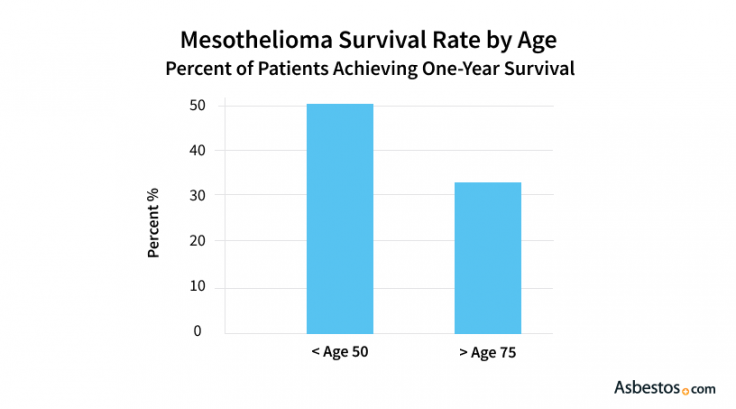
The 5-year survival rate also appears to vary between races. The most recent year for compiled data by race is 2015 when the reported 5-year survival rate was 18.6% for Black people and 9.4% for those who are white.
The mortality rate for mesothelioma is about 0.8 cases per 100,000 people, according to CDC data collected from 1999 to 2020. During that period, a total of 54,905 Americans died from mesothelioma.
The death rate for mesothelioma is close to the incidence rate, which is about 1 case per 100,000 people. The rate is 0.2 per 100,000 for women and 0.6 per 100,000 for men.
The mesothelioma mortality rate varies throughout the United States. Higher rates exist in areas with a strong history of industrial work and manufacturing.
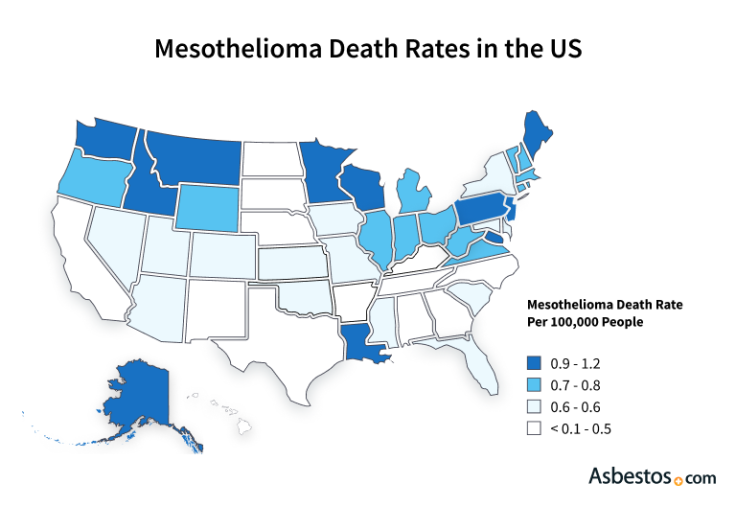
California, Pennsylvania, Texas, New York and Ohio had the highest mesothelioma-related mortalities between 2016 and 2020. Delaware’s mortality rate during this period was 1.2 per 100,000 people. Maine’s was 1.1 per 100,000 and Alaska’s was 1.0 per 100,000. Puerto Rico, however, had a mortality rate of 0.1 per 100,000 and both Georgia and Alaska had rates of 0.4 per 100,000.

While mesothelioma is difficult to treat, advances in treatment approaches have shown significant promise for improving life expectancy for patients. Multimodal approaches that combine approaches, including traditional therapies with emerging treatments, have had significant results.
The future of treatment for cancer, including mesothelioma, is really now. The FDA has a number of targeted therapies approved, as well as immunotherapy, and we’re finding, even in mesothelioma, many of these are effective for types of diseases who historically were difficult to treat.
A recent study presented at the European Lung Cancer Congress showed a combination of surgery, chemotherapy and radiation produced a 1-year survival rate of 79.6% for pleural mesothelioma patients. An International Journal of Hyperthermia study also showed median disease-free survival was almost five years for peritoneal patients receiving surgery combined with heated chemotherapy called HIPEC surgery. The median overall survival was more than eight years.
Mesothelioma treatment may involve surgery, chemotherapy and radiation therapy. More than 80% of patients receive chemotherapy, the most common treatment for mesothelioma. Chemotherapy may triple the survival rate of mesothelioma patients, according to a study of SEER data.
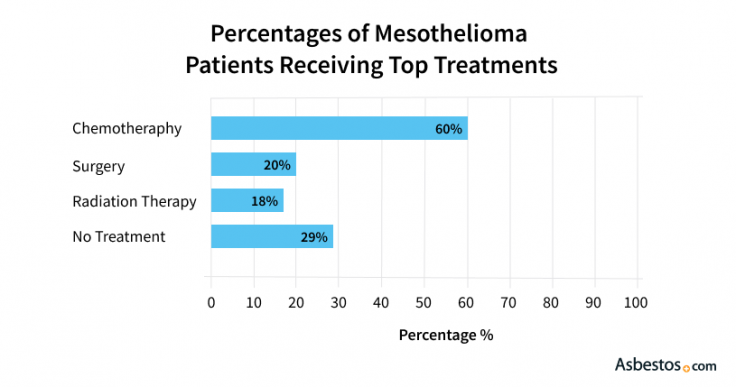
Half of peritoneal mesothelioma patients who receive HIPEC surgery live longer than five years. Only about 20% of pleural mesothelioma patients, however, are eligible for aggressive tumor-removing surgery.
Mesothelioma is a complex disease, and few doctors have experience diagnosing and treating it. Mesothelioma specialists offer patients the best options.
Human studies, called clinical trials, give patients access to the latest breakthroughs in treatment. Researchers have conducted more than 300 clinical trials for mesothelioma worldwide.
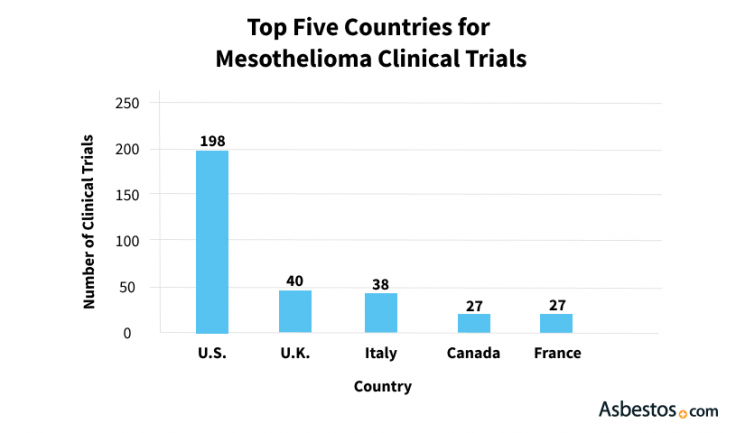
Researchers are testing new drug regimens for those who don’t qualify for surgery. These include drugs already used in lung cancer treatment. Patients may also enroll in clinical trials for emerging treatments such as immunotherapy.
Treatment for mesothelioma isn’t easily affordable for most families. National Cancer Institute statistics estimate the cost of lung cancer treatment at more than $60,000 for the first year. Mesothelioma treatment costs are comparable.
Compensation is available to help patients pay for cancer treatment and related health care costs. Families use mesothelioma compensation to cover various expenses such as medical bills, lost wages, travel costs and other losses. In addition to mesothelioma compensation, some people qualify for other forms of financial aid, such as VA benefits and Social Security Disability Insurance.
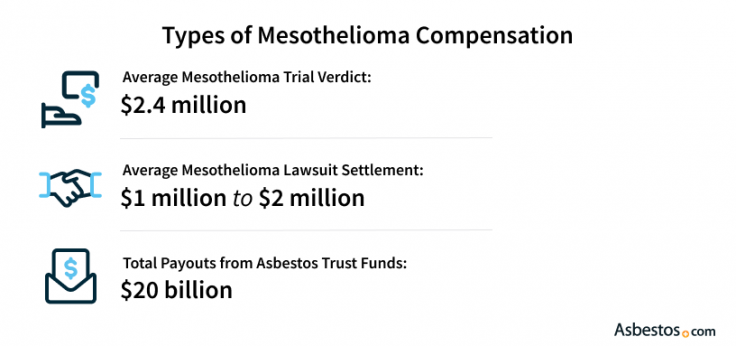
According to data from consulting firm KCIC, mesothelioma lawsuit filings in 2022 totaled 1,859, an increase from 2021’s total filings. Most mesothelioma legal claims settle before reaching trial. The average negotiated mesothelioma settlement ranges from $1 million to $2 million. When cases do go to trial, the average mesothelioma verdict is around $2.4 million.
Some mesothelioma claims are filed with asbestos trust funds. Companies that used asbestos and declared bankruptcy set up these funds to provide compensation for patients with asbestos-related diseases. The RAND Corporation’s Institute for Civil Justice reported in 2016 that asbestos bankruptcy trusts hold a combined total of more than $30 billion. These trusts have paid claimants roughly $20 billion since the late 1980s.

It’s important for patients and families to seek out financial assistance. You really can’t expect what a diagnosis is going to cost for treatment, or at-home care or what your family’s needs are. So, it’s always important to plan for the future.
More data and statistics are available from additional cancer resources. Local hospitals, cancer centers and nonprofit cancer organizations can also be helpful sources for statistical data.
The Patient Advocates at The Mesothelioma Center can also provide you with key resources and information about mesothelioma. Their experience working with mesothelioma survivors and their families, top mesothelioma specialists and cancer treatment centers around the country have provided them with a unique point of view, making the team a valuable resource for the mesothelioma community as well.

Have a question? Contact one of our Patient Advocates and get the answers you need.

Connect, share stories and learn from the experiences of others coping with mesothelioma in one of our support groups.

We help support charities, hospitals and awareness groups working to help people impacted by asbestos and cancer.
Your web browser is no longer supported by Microsoft. Update your browser for more security, speed and compatibility.
If you are looking for mesothelioma support, please contact our Patient Advocates at (855) 404-4592
